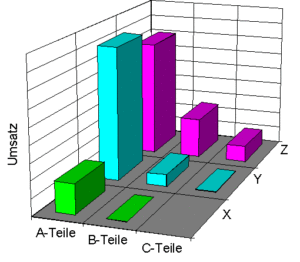Montblanc overcomes the limits of Kanban
The range of articles at the writing instrument manufacturer Montblanc in Hamburg places different demands on the dimensioning of the Kanban control loops. Some production areas work with large batch sizes due to the process, while others are characterized by minimal to no set-up times. In addition, customer consumption fluctuates between continuously small quantities and individually requested large quantities. Thanks to the SAP add-on module SAP-ZDK (SAP additional Kanban dimensioning), employees are now able to re-dimension individual or all Kanban control cycles quickly and at short notice. Deviations are thus detected at an early stage and can be implemented precisely. And for the first time, this also applies to all items, regardless of the fluctuation in demand and frequency of consumption.
Due to fluctuations in customer demand, changes in production processes and production parameters, every Kanban organization requires a regular review of the dimensioned control loops. As a rule, this is done using the “classic” Kanban formula. However, the formula, which is also used in SAP (PP module), only uses the following parameters when dimensioning Kanban control cycles
- Replenishment time per Kanban,
- Average consumption of the item (historical),
- quantity per Kanban container and the so-called
- Safety factor that is specified manually by the user.
With this approach, the number of kanbans in circulation and thus the stock level essentially depends on the safety factor, which is not determined mathematically and analytically, but by gut feeling. Other determinants that influence the Kanban control cycles are, for example, the supplier’s lot size, the customer’s lot size/consumption units and the item’s consumption behavior.
These variables are not taken into account in the classic Kanban formula. So not even in SAP’s Kanban calculation. For this reason, Montblanc decided to use the ZDK add-on tool, which is being used for the first time at Montblanc. It is the logical continuation of dimensioning with the help of mathematical-analytical processes, as they have been used for years in the MRP process with Diskover and which are now being used for the first time from the warehouse in production or in Kanban delivery systems for production.
Don’t lump everything together
At Montblanc, the characteristics of the range of articles place very different demands on the dimensioning of the Kanban control loops. There are production areas (suppliers) that work with large batch sizes due to the process and other areas that are characterized by minimal to no set-up times. This also applies to the receiving production supply areas (consumers/customers): Some consume the components provided continuously in very small quantities, while others purchase large and very large quantities in a single day depending on the batch size and then do not consume any components at all for several days.
In addition, the market behavior of writing instruments and thus the consumption behavior of the individual components varies greatly due to the wide and varied range of products. There are regular (X-items), irregular (Y-items) and also some sporadic (Z-items) components. Sporadically running items are not considered suitable for Kanban control according to the general Kanban theory. However, this is not correct. Each article can be kanban-controlled regardless of its consumption behavior. The only decisive factor for sporadic items is the level of safety stock required for smooth control. However, because this has no mathematical-analytical basis in the classic Kanban formulas, including those used by SAP, it is understandable why the general Kanban theory classifies Z-items as not suitable for Kanban. It is simply not possible to set a safety stock for an item with sporadic consumption behavior manually and thus based on gut feeling. It goes without saying that in most cases, if not always, this is bound to go wrong. But even with X and Y articles, this is only insufficiently successful. The safety stock is usually set too high for these items so that the stocks in the control loops do not run out.
Delivery reliability, historical reject factors and the capacity situation also influence the dimensioning and therefore the number of kanbans in circulation. Optimization of inventories, throughput times and delivery service can therefore never be achieved with classic Kanban dimensioning.
Even if the aspects of simplicity, transparency and decentralization of control responsibility are at the forefront of Kanban control, simplicity in Kanban dimensioning must not be confused with uncomplicated or non-complex and lead to a waste of resources in the form of excessively high inventories, excessively large storage areas or control loops that do not function smoothly. These are the most common reasons for the overall failure of Kanban control.

Company-specific master data important
With the SAP-ZDK add-on module for the SAP system, these requirements can now be taken into account. The first step is to add company-specific master data fields to the control cycle master data. At Montblanc, these included the approach planning factor, the lead time, the maximum batch size (supplier), the maximum required quantity (customer), the degree of readiness to deliver and the scrap factor.
Once this data has been maintained, the dimensioning can begin. The program takes the planned sales quantities of the end devices from SAP planning and uses the BOM explosion to determine the monthly values for all kanban-controlled components. These values form the basis for dimensioning because they are used to determine the basic and safety stock for each component depending on the consumption behavior (XYZ components). The defined parameters of each individual component and a simulation period of five years are now used to test the number of kanbans that need to be fed into the system. The safety stock is constantly monitored to ensure that it is sufficient to prevent the system from running empty and that no superfluous Kanban containers are circulating in the system. The following results, among others, are made available to the dispatchers to evaluate the system:
- Number of kanbans required and difference to the current situation,
- Maximum number of Kanban containers in the storage area,
- Minimum, average and maximum stock levels,
- basic and safety stock on the basis of the WBZ, as well as the
- Calculation of the average setup processes.
The dimensioning can now be repeated several times by changing the parameters and saved as versions. This allows improvements in stocks, set-up processes, etc. to be weighed against changes in parameters.
The highly diverse Kanban requirements can only be met by a correspondingly differentiated Kanban dimensioning. The actual dimensioning of the individual Kanban control loops and thus the determination of the number of Kanbans or Kanban containers in circulation was therefore based on a broad, mathematical-analytical foundation.
Kanban dimensioning should be future-oriented. Dimensioning with consumption from previous periods must be avoided wherever possible. At Montblanc, the ‘future’ in the form of rolling sales planning is used for the required consumption values. Kanban has thus become an acting rather than a reacting control system.
The frequent lack of regular resizing of the Kanban system leads to wasted resources and disruptions in Kanban control. It must be possible to re-dimension quickly and easily at regular intervals or as required, whether due to changes in sales forecasts or changes in production parameters. At Montblanc, the scheduling department is responsible for this. It can easily and quickly re-dimension each individual item as required or now at regular intervals with the help of the SAP-ZDK add-on module and compare the results with the existing control loops or across different versions and decide what needs to be done.
The regularity of consumption is a key influencing factor for Kanban dimensioning. An XYZ analysis of all articles is therefore an essential prerequisite for a successful Kanban system in order to assess the planning capability of Kanban articles. With the help of this analysis, the behavior patterns of the Kanban items are made transparent. They subsequently lead to a division of the articles into classes to determine suitable planning algorithms and thus to their parameter settings. This classification ultimately determines the amount of safety stocks to be taken into account and thus the additional kanbans circulating in the system.
Calculation method decisive for success
However, it must be noted that the design of a Kanban system depends on the distribution of demand. Since only five percent of empirically determined demand distributions are normally distributed, the correct determination of basic requirements and safety stock using the right calculation methods is crucial for the success of a Kanban system.
With automatic Kanban dimensioning, it is now possible to design a Kanban system in SAP in a more differentiated way and consistently avoid wasting resources. The essential Kanban aspects such as simplicity, transparency and decentralization of control responsibility are even reinforced with this program. Resizing is extremely easy from the user’s point of view. Only the initial dimensioning, i.e. the collection and verification of data and the establishment of the control organization, requires more intensive and thorough work. However, this quickly pays off.


